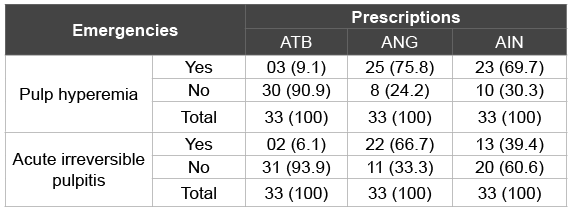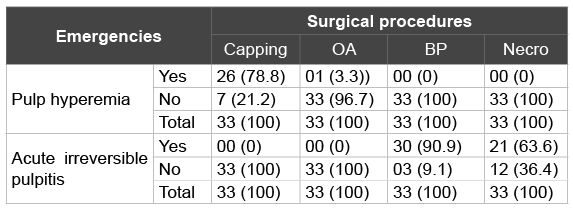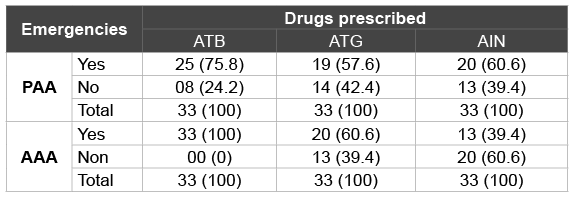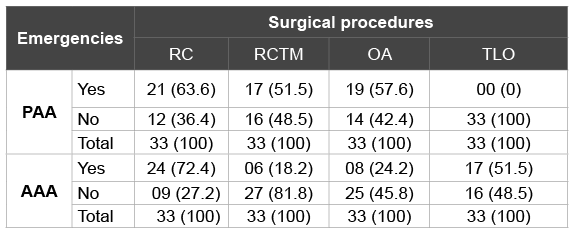
Table 1: Prescription of drugs for the emergency treatment of pulp
hyperemia and acute irreversible pulpitis
ATB=Antibiotic, ANG=Analgesic, AIN=Anti-inflammatory

Wendpoulomdé AD Kaboré1,* Babacar Faye2 Youssouf Ouédraogo1 Tarcissus Konsem1 Khaly Bane2 Mouhamed Sarr2
1Research Center of Health Sciences (UFR/SDS), University of Ouagadougou, 03 BP 7021 Ouagadougou 03, Burkina Faso*Corresponding author: Dr Wendpoulomdé Aimé Désiré KABORE, Research Center of Health Sciences (UFR/SDS) University of Ouagadougou, 03 BP 7021, Ouagadougou 03, Burkina Faso, E-mail: dr_kabore@yahoo.fr
Treatment of emergencies stemming from endodontic issues in a dental surgery requires making a precise diagnosis and performing an emergency procedure that may also entail prescription of drugs to treat the condition. The aim of this work was hence to assess the surgical procedures and the use of prescription drugs by dental surgeons in Burkina Faso to manage the treatment of such emergencies.
This was a descriptive cross-sectional study conducted with dental surgeons in Burkina Faso. Occupational data regarding the practitioner, the surgical procedure, and the medications prescribed were obtained and compiled using a data collection form to assess the approaches used by practitioners to address endodontic emergencies.
Thirty-three practitioners participated in this study. The results revealed that suitable emergency procedures were used by most dentists (78.8%) to treat hyperemic pulp, while for acute irreversible pulpitis this figure was 90.9%, acute apical periodontitis 51.5%, and for an acute apical abscess it was 72.7%. By contrast, prescription of medications for such emergency conditions was found to often be inappropriate. Furthermore, analysis of the results regarding the occupational data and the data concerning specifics relating to the treatments investigated in this study have shown that, irrespective of the sector of their engagement, dental surgeons invariably prescribed drugs whether or not a surgical procedure was performed.
This study has shown that there is ample room for improving endodontic emergency treatments in Burkina Faso.
Emergencies; Endodontic treatments; Epidemiology; Burkina Faso
An emergency occurs when “a pathological condition requires that a diagnosis and treatment must be performed without delay” [1].
Odontological emergencies concern various pathologies that are mainly of an infectious, inflammatory, or traumatic nature. Most often they are not life-threatening, although the associated pain can be highly debilitating for the patient, hence requiring being treated without delay [2]. With the exception of prosthetic emergencies, dental emergencies most often arise due to the painful condition experienced by the patient. It is consequently the duty of the practitioner to attend to the patient so as to provide them with a degree of relief. In all circumstances, this pain must be prevented, assessed, taken into account, and treated.
Aside from dental and alveolar trauma, endodontic emergencies depend on the severity of the condition, regardless of whether it is of a bacterial, mechanical or chemical origin. The severity of the condition typically depends on the intensity of the inflammatory response in the pulp and periradicular tissue.
Providing proper care for endodontic emergencies is important because it can have profound bearings on the success of the etiological treatment [3]. It accounts for about 60% of the reasons for seeking a consultation for endodontic emergencies [4]. The treatment starts with identification of the causative tooth, followed by establishing a diagnosis of the underlying pathology, and then implementation of an adequate emergency therapy that may be in conjunction with the administration of prescription drugs [5,6]. The practitioner must systematically question the patient regarding their condition, perform a clinical examination, reach a clear and distinct diagnosis, and provide emergency treatment [7].
The aim of this study was to analyze the surgical procedures and the extent to which drugs are prescribed for endodontic emergencies by dental surgeons in Burkina Faso.
This was a descriptive cross-sectional investigation involving all of the practitioners who were registered members of the National Burkina Faso College of Dental Surgeons, engaged in private, public or semi- public practice. It took place from the 27th of February to the 31st of May 2015. An enquiry form based on the modified Westaphen model was used that covered the following topics: occupational data, the frequency of endodontic emergencies encountered by the practitioners, and their disposition toward recommended therapies.
The practitioner’s level of knowledge was assessed by proposing various endodontic emergency diagnostic methods in the questionnaire.
Statistical analysis of the data was done using Sphinx Plus2 version 5.0.0.75 software. Chi-squared (Chi2 ) testing was used to compare two qualitative variables. Differences were deemed to be significant when p<0.05.
Thirty-three practitioners participated in this study. The public sector was represented the most, at 54.6%, the private sector at 24.2%, the army health services at 15.2% and the semi-public sector at 6.1%. The total duration of employment in this profession was divided into three categories: 0-5 years, 6-10 years, and 21-25 years, amounting to 18.2% each. The proportion of dentists who underwent continuous training was 84.8%, and the most common means for achieving this were attending meetings (63.6%) followed by obtaining training through the internet or books (60.6%). On the other hand, 15.2% of the study population did not partake in any continuous training. The proportion of dentists who attended to 6 to 10 patients per day was 36.4%, and only 15.2% of the practitioners attended to more than 20 patients per day.
Treatment is managed by prescription of drugs (Table 1).
It can be seen that for the treatment of pulp hyperemia 78.8% of the practitioners perform capping, followed by prescription of an analgesic by 75.8%. For treatment of acute irreversible pulpitis 90.9% perform a biopulpectomy and for 66.7% this entails prescription of an analgesic (Table 2).
For Acute Apical Periodontitis, 51.5 % of the dentists performed root canal trimming in conjunction with medication, 57.6% resorted to adjusting the tooth occlusion, followed by prescription of drugs. For 57.6 % it was an analgesic or an anti-inflammatory for 60.6%, while 75.8% added an antibiotic in addition to the analgesic or the anti-inflammatory. Lastly, faced with an acute apical abscess, 100% of the practitioners prescribed an antibiotic (Table 3). Root canal drainage was performed by 72.7% and extensive opening of the tooth by 51.5%. Incision of the mucosal membranes was reported by 48.5 % of the practitioners. Yet 27.3 % considered extraction of the causative tooth, if it was toward the back of the mouth (Table 4).
This study conducted with 33 dental surgeons indicates that male practitioners (60.6% of the study population) are more numerous than females (39.4% of the study population). The same trend was seen in Senegal and in India. Indeed, a study performed by Toure et al. [8] in 2007 showed that in the Dakar area male practitioners accounted for 65.1% and female ones for 34.9%. Verma et al. [3] showed that 34.2% of Indian dentists are women and 65.8% are men.
Private practice accounted for 24.2% of the dental surgeons. The government sector (i.e. public, semi-public and armed forces) accounted for 75.8%. In this regard, our results do not match those of a study performed in Nigeria [9]. Indeed, the report by the executive of the Human Resources and Health Card Service of Nigeria indicated that the capital (Lagos) had a high level (86.44%) of dentists in private practice. The level of dental surgeons practicing in the private sector in Nigeria is 78.57% according to Akpata et al. [7]. Furthermore, Toure et al. [8] have shown that private practice accounted for 60.4% of dentists in the Dakar area of Senegal, while the public and semi-public sectors accounted for 39.6%.

Table 1: Prescription of drugs for the emergency treatment of pulp
hyperemia and acute irreversible pulpitis
ATB=Antibiotic, ANG=Analgesic, AIN=Anti-inflammatory

Table 2: Use of surgical procedures for emergency treatment of pulp
hyperemia and acute irreversible pulpitis
BP= Biopulpectomy, OA= Occlusion adjustment

Table 3: Prescription of drugs for emergency treatment of Acute Apical Periodontitis (PAA) and Acute Alveolar Abscess (AAA)

Table 4: Surgical procedures used for emergency treatment of Acute Apical Periodontitis (PAA) and Acute Alveolar Abscess (AAA) RC=Root canal drainage, RCTM=Root canal trimming and medication, TLO=Tooth left open, OA=Occlusion adjustment.
The vast majority of those surveyed have been practicing for less than 20 years. The study by Toure et al. [8] in Senegal came up with the same results. Continuous training has been mandatory in France since 2006 for all practicing dental surgeons [10]. The aim of this law is to ensure the knowledge base of practitioners is up to date. In Burkina Faso, 87.9% of the practitioners engaged in continuous training through the internet while 12.1% did not partake in any training. This situation results in problems in terms of being up to date, and it could explain the observed deficiencies.
Practitioners who attend to between 16 and 20 patients per day accounted for 15.2% of those surveyed, while 36.4% treated between 6 and 10 patients. By contrast, according to Toumelin-Chemla [10], 61.9% of practitioners in France see more than 20 patients per day. The relative inaccessibility of oral and dental hygiene to the Burkinabe population, relative to that in France, could explain this difference.
Disposition of dental surgeons regarding endodontic emergencies
Faced with pulp hyperemia, the surveyed dental surgeons resorted either to just prescribing analgesics (75.8%) or anti-inflammatory drugs (69.7%), or just a surgical intervention (78.8%) or a combination of the two (79.3%). These results indicate the surgical procedures that are used are appropriate, and that they are in keeping with the literature [11-13] which recommends elimination of the tooth decay followed by hermetical sealing of the dentin tubules by placement of a waterproof filling. On the other hand, prescription of drugs is not in keeping with what has been reported in the literature. Indeed, prescription of just analgesics, or postoperatively in conjunction with surgery, is not necessary [4,6,14,15]. Regardless of the number of patients attended to, or the private versus public setting, in our study dentists prescribed analgesics irrespective of whether a surgical procedure had also been performed. This disposition seems to stem from a lack of time due to overcrowding in the public sector, or from fear of undergoing dental care.
For the treatment of acute irreversible pulpitis, the practitioners performed two types of procedures. Just a biopulpectomy was relied on by 90.9 %, while the remainder prescribed arsenic trioxide. None of the dentists adjust the tooth occlusion. These results conform to the guidelines or recommendations by the relevant professional associations since, following anesthesia; the appropriate pain management consists of fully removing the pulp tissue. If the pain persists, prescription of an analgesic may be warranted [6]. On the other hand, 63.6% of the dental surgeons favor relying on the use arsenic trioxide. Although this is a procedure that is still in use, it should be phased out since a number of authors consider it to be dangerous due to the toxicity of arsenic trioxide [16,17]. The prescription of antibiotics by 6.1% of the practitioners is uncalled for since the condition involves an inflammation of the pulp tissue rather than an infection [16].
As for acute apical periodontitis, the majority of the practitioners (63.6%) favor performing an endodontic cavity access and placement of a Rockle’s root canal antiseptic followed by a temporary dressing. All of them include an anti-inflammatory and antibiotic treatment with this. These results show that this approach is not in keeping with the recommendations in the literature, which advocate root canal trimming followed by adjusting the tooth occlusion and prescription of an anti-inflammatory that allows for pain management while waiting for follow-up etiological treatment [18-20]. Prescription of antibiotics is not necessary, as the trimming provides adequate control of the infection [6].
When faced with an acute apical abscess, 72.7% of the dentists acted in compliance with the current recommendations, which consist of performing drainage of the root canal in conjunction with prescription of an antibiotic [21]. Some authors do not favor prescribing antibiotics along with an analgesic unless complete drainage cannot be achieved [3,8,21]. Prescription of anti-inflammatories, which was done by 39.4% of the dentists, can be seen as being dangerous in the sense that it may promote spread of the infection at the peri-apical level, thus also entailing complications such as cellulitis [10].
Sealing of the tooth should only be done if drainage by the mucosal route has been achieved [15]. Presently, 48.5% of the practitioners refer to performing a temporary obturation with mucosal incision, and 51.5% of the dentists left the tooth open. The last two results indicate the general adequacy of this emergency treatment. Analysis of the results regarding the occupational data and the data concerning specifics relating to the treatments investigated for the study has shown that the sector in which the practitioner is engaged, or the number of patients that they attend to per day, does not influence their disposition regarding the treatment of the various endodontic emergencies. Results that are counter to ours were presented in the study by Toure et al. [8]. They reported that dentists in the public sector who attend to a lot of patients have a tendency to prescribe drugs instead of carrying out a biopulpectomy, since the latter require more time due to the need for anesthesia and hemostasis [8,6]. Contrary to the study performed in Dakar [8], for which the prognostic values showed that dentists who undergo training following their university studies tend to more often adequately perform the therapeutic procedures, our study was not able to uncover an effect of continuous training on the disposition of the practitioners. For the most part, dental surgeons in Burkina Faso are recent graduates whose knowledge base is more or less up to date. Indeed, 51.5% have been practicing less than 15 years.
Endodontic emergencies represent the main reason for most emergency consultations. All patients presenting with a dental emergency must be seen as soon as possible, and this needs to be taken into account by the team providing the care and in the scheduling of appointments. The treatment provided in an emergency must not compromise subsequent restoration of the tooth. Time constraints and stress of the patient should not cause the practitioner to deviate from good clinical practice.
This study shows that there is ample scope for improving emergency endodontic treatments in Burkina Faso. For this to occur, the health authorities and relevant professional organizations should increase awareness of the need to make continuous training a formal requirement.
Download Provisional PDF Here
Aritcle Type: Research Article
Citation: Kaboré Wendpoulomdé AD, Faye B, Ouédraogo Y, Konsem T, Bane K, et al. (2015) Level of Knowledge and Dispositions of Dental Surgeons in Burkina Faso Regarding Endodontic Emergencies. Int J Dent Oral Health 2(1): doi http://dx.doi.org/10.16966/2378-7090.148
Copyright: © 2015 Kaboré Wendpoulomdé AD, et al. This is an open-access article distributed under the terms of the Creative Commons Attribution License, which permits unrestricted use, distribution, and reproduction in any medium, provided the original author and source are credited.
Publication history:
All Sci Forschen Journals are Open Access